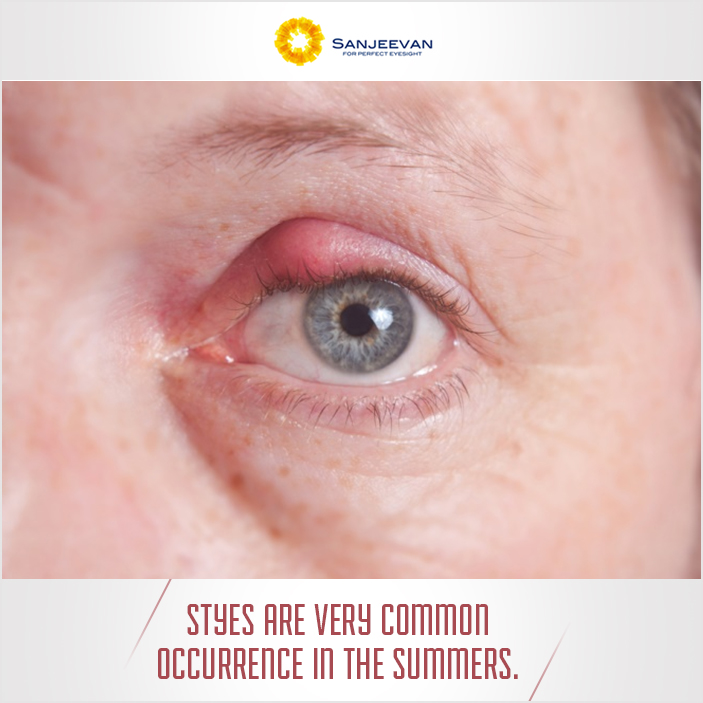Hello Friends!
An extremely hectic schedule has meant that it’s been long since I’ve last blogged but the advent of summer season has brought with it some breathing space for me! However, unfortunately, breathing space is not the only thing that the advent of summer brings with it. So what else does it bring with it you ask? Aside from being known for all the warmth, shine & the holidays, the summer season is also notoriously famous for being touted as the breeding season of several infections & diseases. And one of several those summer infections will be the topic I will discuss with you in further detail in this blog – The infection in question is the largely widespread “Hordeolum” or what you more commonly refer to as “Eye Stye”.

What is an ‘Eye Stye’?
For those still wondering, ‘Stye’ or ‘Hordeolum’ is a small, painful lump on the inside or outside of the eyelid. It is actually an abscess filled with pus and is usually caused by a staphylococcus bacteria eye infection. Styes are common with most people experiencing one or two of them at some stage in their life. Styes are usually visible on the surface but can appear deeper inside the eyelid. Now that we’ve established what “Eye Stye” is, let me go further to explain why this condition becomes more potent & prevalent in the summers..
‘Eye Infections’ & the ‘Summer Season’ – The Connection:
For a start, pardon me as I divulge for a moment and ask all of you from Mumbai – Isn’t it quite inexplicable how every summer, the BMC are back reconstructing the road they constructed last year? I won’t be exaggerating if I say that virtually the whole of Mumbai gets dug up every summer! “So, what’s the relevance of that with an eye disease Dr. Goyal?” some of you might be thinking. Let me explain – the flying grit from off-roading or yard work, construction sights & road maintenance coupled with a sun that sears delicate tissues makes the summer season nothing short of an obstacle course for your precious eyes!
Now, let me specifically talk about styes – Styes are usually caused by a combination of a clogged oil gland and staphylococcal bacteria, which often live right on the skin surface. Our bodies are coated with billions of friendly bacteria that coexist with us. When the conditions are right, the bacteria become overabundant, resulting in the tender pimple. And these “right conditions” being referred to here are nothing but the soaring temperatures & relentless heat that the summer season brings with it.
Habits acting as Catalysts to stimulate ‘Stye Growth’ :
Now that we’re clear on the summer season being ideal for bacterial growth & thus styes, I’ll now talk in brief about a few habits we can correct to minimize the risk of contracting this condition in this season. Habits such as:
- Not removing makeup before bedtime
- Using old, contaminated cosmetics or cheap ones
- Rubbing the eyes with unclean fingers
- Inserting and removing contact lenses with unclean fingers
- Not following proper contact lens hygiene
- Swimming without wearing swimming goggles
All these habits are nothing but catalysts for bacterial growth around our eyes & thus a major contributing factor to infections such as an ‘Eye Stye’.
Dealing With Styes:
While I’m sure that all of you will agree that “Prevention is better than Cure”, there are times when even the most cautious are caught off guard by an ‘Eye Stye’. It is for them and all those who by now would surely be thinking “What if after doing all this, I still develop an Eye Stye. Can nothing be done?” that I will now provide some vital rearguard action advice for dealing with ‘Styes’:
The first line of treatment should always be hot compresses and eyelid hygiene. When it is painful, it is usually in the acute phase and at this time it responds well to hot compresses.
Because a stye is well sealed from the outside, antibiotic drops do not penetrate very well to the site of infection. However, hot fomentation or applying heat to the inflamed area normally works. The most important aspect of heat application is to do it as frequently as possible especially during the initial phase of the stye. An acutely inflamed stye may begin to drain and at this point topical antibiotic eye drops may help. While I have stated that antibiotic eye drops are not the most effective for treating this condition, I suggest that you rely on ‘Aloe Vera Eye Drops’ instead – these are not just useful in treating Eye Styes but are also useful for preventing them in the first place!
Eyelid hygiene: Stop using eye make-up for a while as make-up can be contaminated with bacteria. Apply baby (tear-free) shampoo to a clean, wet wash cloth or ear bud and gently rub along the eyelid margins once a day. Some prefer using commercially available pre-moistened eyelid wipes. Any mild analgesic and anti-inflammatory tablet may also help reduce painful discomfort.
So, there you have it! All that you needed to know about Eye Styes, preventing them and coping with them this season. Before signing off though, I would wish to state that while I have provided you with the basic information for dealing with Eye Styes, I would yet insist that you seek professional medical help for treating this condition, if it was to arise.
Lastly, if you have any queries with regards to this or any other condition of the eye, feel free to get in touch with me at ‘[email protected]’; as always, I’ll try to revert to your queries at the earliest possible.
Signing Off,
Dr. K.K. Goyal.
